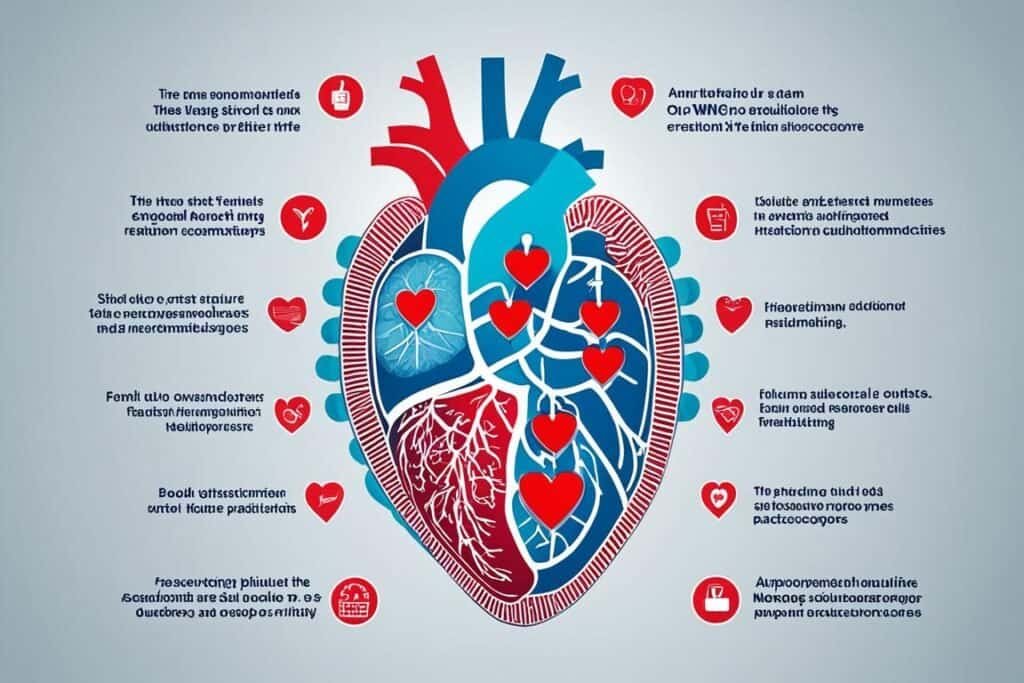As a healthcare professional in India, you’re at the forefront of combating a major public health issue—heart failure. With the WHO heart failure guidelines at your disposal, you now have the critical resources necessary to elevate heart failure management in India. These international standards are designed to integrate with the Indian healthcare system seamlessly, ensuring that you can provide care that is both cutting-edge and culturally appropriate.
Whether you are developing heart failure treatment protocols or seeking to improve patient outcomes, these WHO-endorsed guidelines are your blueprint to success. By delving into this comprehensive framework, you’re not only enhancing your own medical practice but also contributing to a broader effort to standardize and optimize cardiac care throughout India’s diverse landscape.
Key Takeaways
- Utilize WHO guidelines to standardize heart failure treatment across India.
- Understand the crucial role of early diagnosis and personalized care in heart failure management.
- Adopt evidence-based treatment strategies tailored for Indian patients.
- Contribute to the reliability and effectiveness of the Indian healthcare system through guideline adherence.
- Be aware of the impact of heart failure on India’s health landscape and aim for improvement.
Understanding Heart Failure and Its Prevalence in India
Heart failure (HF), a condition that strikes millions worldwide, has now become a growing health crisis in India. When addressing heart failure diagnosis, it is crucial to recognize the pivotal heart failure risk factors that contribute to the escalating numbers. In this context, India stands out due to a higher instance of chronic heart failure among its population, especially at younger ages than observed globally.
India’s heart condition prevalence is concerning, with a vast number of cases stemming from an interplay of genetic, environmental, and lifestyle factors. A deeper understanding of these contributing elements is essential for healthcare professionals aiming to combat the rise of this life-threatening ailment effectively.
- Increased urbanization leading to sedentary lifestyles
- High prevalence of diabetes and hypertension
- Challenges in healthcare delivery and access
The burden of HF in India not only underscores a pressing need for comprehensive health policies but also accentuates the urgency in enhancing awareness and preventive strategies. With India’s healthcare framework facing the brunt of this surge, identifying and managing HF has become more important than ever.
| Age Group | Incidence of Heart Failure | Common Risk Factors |
|---|---|---|
| Higher than global average | Hypertension, Diabetes, Obesity | |
| 60+ years | Increasing rapidly | Aging, Chronic Kidney Disease |
As we witness an uptick in chronic heart failure, understanding the nuances behind these statistics is not just academic but a necessity. Bridging the gap through educational programs targeted towards both the public and healthcare providers can play a significant role in altering the course of India’s heart condition trajectory. The key lies in early detection, judicious management, and mitigating risk factors to curb the overwhelming tide of HF cases in India and move towards a healthier future.
WHO Heart Failure Guidelines: A Synopsis for Indian Healthcare Practitioners
The World Health Organization (WHO) has crafted comprehensive heart failure guidelines that serve as an invaluable resource for Indian healthcare providers. These guidelines are especially pertinent given the distinct clinical profile of Indian patients, who typically exhibit symptoms of heart failure at a younger age compared to their Western counterparts. Emphasizing the gravity of cardiac care, the guidelines are a cornerstone for clinicians in India, aiming to reduce the high mortality associated with heart failure.

Recognizing the vast spectrum of heart failure, the WHO categorizes the condition into two primary types: heart failure with reduced ejection fraction (HFrEF) and heart failure with preserved ejection fraction (HFpEF). Such categorizations aid medical professionals in India to tailor their approach to treatment and management of the disease.
With the adherence to these heart failure recommendations, the therapeutic strategies incorporate critical pharmacological interventions. Angiotensin-converting enzyme inhibitors, beta-blockers, and other vital medications are prioritized within the treatment regimen. It’s essential for healthcare practitioners in India to be well-versed in these guidelines to ensure efficacy and elevate the standard of cardiac care.
- Analyze patient’s profile and identify the type of heart failure.
- Apply guideline-directed medical therapies as recommended by the WHO.
- Monitor patient progress and adjust treatments as necessary.
The WHO heart failure guidelines are more than a set of instructions; they are part of a broader initiative to enhance the quality of heart failure management across Indian healthcare systems. It’s a call to action for providers to implement best practices and ensure that patients receive the highest standard of care.
Diagnosing Heart Failure in India: Adhering to WHO Recommendations
For healthcare practitioners in India, the heart failure detection process is a pivotal aspect of cardiovascular health management. As per WHO diagnostic criteria, it is crucial to identify heart failure through a combination of clinical evaluation and advanced medical imaging, such as echocardiography. The inclusion of biomarkers, specifically B-type natriuretic peptide tests, has become an integral part of the diagnosis process, offering valuable prognostic insight.

India, with its growing number of heart failure cases, utilizes local registries, including the Trivandrum Heart Failure Registry, to fine-tune diagnostic accuracy. This registry sheds light on both the prevalence and the unique progression of heart failure amongst the Indian population, thereby improving management strategies informed by WHO guidelines.
Understanding the WHO recommendations ensure that you, as a healthcare provider, can offer your patients a higher standard of care aligned with international practices. Here’s a breakdown of the WHO endorsed diagnostic flow:
- Initial Clinical Assessment: Includes patient history, symptoms, and physical examination.
- Application of Biomarkers: Utilizing BNP and NT-proBNP measurements for diagnostic confirmation.
- Echocardiography: Essential for evaluating heart structure and function to ascertain the type of heart failure.
Below is the comparative insight into the manifestations of heart failure in India:
| Parameter | Typical Presentation in India | WHO Criteria Alignment |
|---|---|---|
| Age at Diagnosis | Often diagnosed at a younger age | Focus on early diagnosis |
| Risk Factors | High prevalence of diabetes and hypertension | Emphasis on managing comorbid conditions |
| Clinical Presentation | Diverse, often with advanced symptoms | Comprehensive clinical evaluation recommended |
The implementation of these structured diagnostic approaches has the potential to significantly improve both prognostic and therapeutic outcomes for patients with heart failure across India.
Preventive Strategies and Treatment Options for Heart Failure
Implementing heart failure prevention measures is essential in reducing the growing burden of heart failure (HF) in India. As per WHO guidelines, addressing modifiable risk factors remains the cornerstone of prevention. Your role in managing high blood pressure, maintaining controlled glucose levels, and managing cholesterol is critical. Embracing a healthy lifestyle that includes balanced nutrition and regular physical activity can substantively mitigate the risk of developing HF. Additionally, monitoring for and managing overweight and obesity can not only prevent heart failure but also optimize overall cardiovascular health.
When it comes to heart failure management, the Indian healthcare system is tasked with ensuring the availability of essential noncommunicable disease (NCD) medicines and health technologies across primary care facilities. This commitment is vital to provide equitable access to care and treatment for all patients. Once a diagnosis of heart failure is confirmed, adhering to WHO-approved heart failure medication regimens tailored to the individual’s specific condition is paramount. Medications often include diuretics, ACE inhibitors, and beta-blockers, among others, forming the backbone of therapeutic management.
For some patients, beyond pharmacological interventions, Indian cardiovascular treatments may involve more advanced options like device implantation or surgical procedures. These interventions are reserved for cases where medication and lifestyle interventions may not suffice. It is incumbent upon healthcare professionals to ensure that such treatments are accessible and that they align with international best practices while being adapted to local healthcare conditions. Your involvement as healthcare providers in the proactive management of HF can significantly improve patient outcomes and stem the tide of heart failure’s impact in India.

